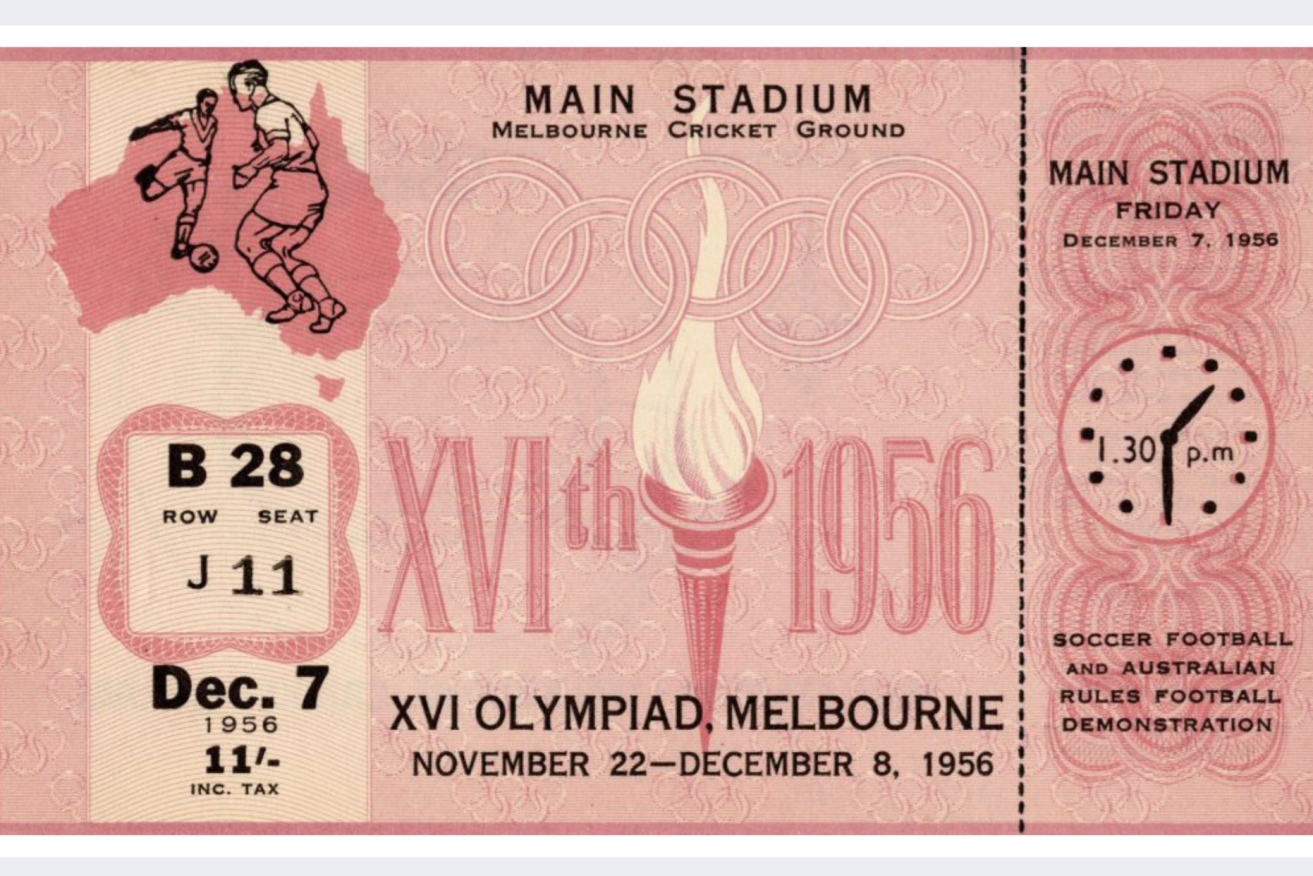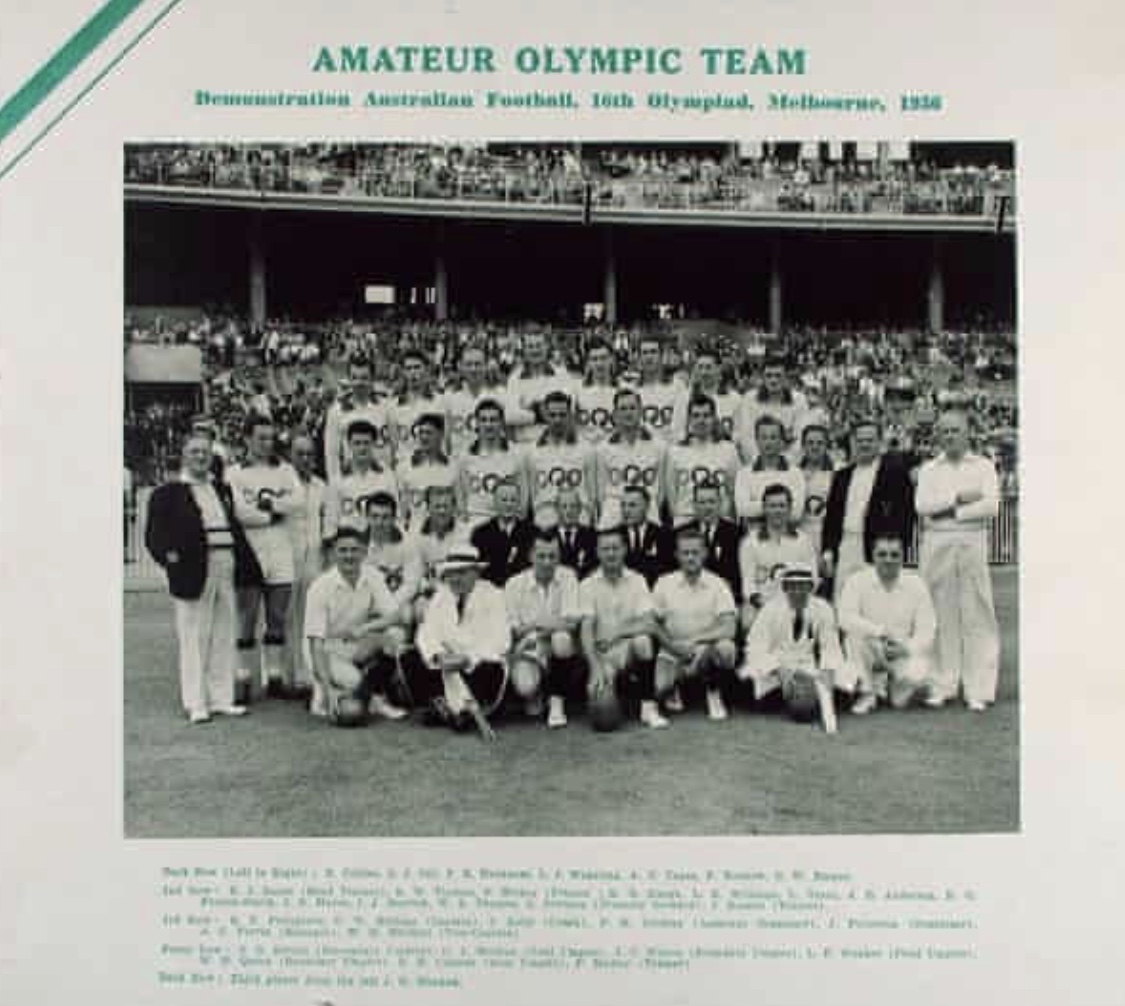AFL’s chance to take on rugby at Brisbane Olympics
Rugby league is jostling for a place in Brisbane’s 2032 Olympic Games program. Will Australian football – a demonstration sport at the 1956 Melbourne Olympics – demand a piece of the action? Michelangelo Rucci reports.

Image: MCC collection
South Australian-born Lindsay Gaze’s official resume includes five Olympic Games, starting in Tokyo in 1964 as one of Australia’s first basketball players to compete in the medal rounds, and four (1972, 1976, 1980 and 1984) as the Boomers coach.
But his Olympic story actually begins at home in 1956 with: Australian football.
Gaze, the father figure of Australian basketball, first wore the Olympic rings in Melbourne while playing – “when available,” he says – as an amateur at Victorian Football Association club Prahan.
“But I was not an Olympian in 1956,” stresses Gaze, now aged 84.
Australian football’s unheralded presence in the Olympic program was ratified on July 16, 1954 as one of two “demonstration” sports for the Games – as the host country’s “national game”, while baseball was the “foreign” offering.
This system, introduced at the 1908 London Games as a method of auditioning future Olympic sports, was gone when the Olympics returned to Australia in Sydney in 2000. It has been revived at Tokyo with a sumo wrestling exhibition tournament.
And the opportunity will arise again with Brisbane hosting the Olympics in 2032 – 50 years after the city included Australian football (and table tennis) as demonstration sports at the 1982 Commonwealth Games. In an entertaining rematch of the 1982 VFL grand final played just 11 days earlier, Richmond reversed the result by scoring an 18-point win against Carlton at the Gabba.
Rugby league already has moved to avert the AFL cutting in again on traditional rugby soil and the world’s biggest sporting stage. International rugby league executives started lobbying the Queensland State government during the NRL Magic Round in Brisbane in May, seeking to have its nine-a-side and wheelchair formats become part of the 2032 Olympic program.
“We have indicated that the Olympics are a priority for us,” says International Rugby League chairman Troy Grant whose sport has had Commonwealth Games status since 2014. “We will be doing all we can to be included, either as a demonstration sport or, potentially, as an allocated sport.”
Today, the AFL – that has more-pressing issues saving its current premiership race from COVID-induced challenges – is still to put the 2032 Olympics on its agenda. So far, there has been no-one at AFL House search out the file on “AFLX” format of eight-a-side football played on a rectangular pitch across 10-minute halves, which was introduced to the league’s pre-season calendar in 2018 and packed away in 2019.
AFL chief executive Gillon McLachlan noted at the time “we have had trouble taking our game internationally … AFLX is not our traditional game, but it has the best bits of it.”
The AFL Fans Association has opened the public discussion on Australian football writing another chapter in Olympic history. The lobby group has sought feedback on Brisbane offering an encore to 1956 by asking on social media on Monday: “With the 2032 Brisbane Olympic Games announced, the host country is allowed to have a demonstration event. Should the AFL petition the government and be successful, would you rather see a game (or games) of normal AFL/AFLW, International Rules, AFLX, State-of-Origin or other games?”
Another option is to revive the COVID-stalled Australian Football International Cup tournament. Launched in 2002, its last edition in 2017 involved 18 men’s teams and eight women’s sides from around the world. The 2021 series was – before COVID closed Australian borders – to have been played in July-August on the Sunshine Coast in Queensland and remains in the “postponed” phase while the pandemic grips the world.
Despite replica wool guernseys from the 1956 Olympic play-off between two Victorian representative teams at the MCG being part of the memorabilia sold during the 2000 Games in Sydney, very few AFL fans – and probably not many current AFL executives – know that Australian football has an Olympic chapter.
“And while we were not Olympians, we were held to the strictest Olympic ideal of amateurism,” Gaze recalled to InDaily. “The International Olympic Committee was more zealous about our sporting backgrounds than it is today with drug cheats. The amateur status of the Games was very serious then.”
The match, played at 4.10pm on December 7, 1956 at the end of the Olympic program, directly after the bronze medal was settled for the world football with Bulgaria beating India 3-0 on the MCG, was between a combined VFL-VFA squad and the better-prepared players from the Victorian Amateur Football Association.
“The VFL players were very talented young men who were destined to become superstars,” says Gaze referring to eventual household names such as Collingwood’s 1958 premiership hero Ray Gabelich. Their captain was Melbourne premiership ruckman and captain Denis Cordner who months earlier, at the end of the 1956 football season, had retired from the VFL.
“What the VFL players claimed and what evidence there was to contradict it probably gave us the first example of ‘shamateurism’ at the Olympics,” said Gaze. “Not that these VFL players were receiving spectacular money to play in the VFL while training twice a week between games in the winter.”
The delightful note from the 1956 demonstration match is how the true amateurs from the VAFA honoured the spirit of the modern Olympics’ founder Pierre de Coubertin by beating the semi-professionals of the VFL-VFA by 16 points, setting up their win with a six-goal first term. Their greatest lead was 36 points at the last change on an MCG field that still had white-line markings for the athletics track.
The amateurs wore a white guernsey with a emerald green collar and the five Olympic rings on the front of the jumper; the VFL-VAFA players wore a wattle green guernsey with white trim.

Photo: MCC collection
“I didn’t keep mine; I’ve kept very little from my sporting career, but my brother did hold onto his jumper,” said Gaze referring to Barry Gaze who also was at VFA club Prahan and played at centre in the Olympic demonstration match.
“I went to a Collingwood Football Club dinner a few years later and a couple of the Collingwood players brought their Olympic jumpers along. They were half the size – they had shrunk dramatically.”
The black-and-white film that survives of the match includes a narration that tells of how Australian football creates a “fever” in Melbourne “where they even climb the roof” of the MCG to watch matches.
“Not this day; very few attended,” recalls Gaze with Victorians having had their sporting fill with 16 days of Olympic competition. “It was a nice day, a nice friendly game – no sensationalism.”
Gaze was left on the bench. The VFL-VFA team coach, former Collingwood player and the Australian National Football Council secretary Bruce Andrew, did not at any stage have a comfortable scoreboard lead offering him the luxury to mix his line-up by handing game time to those sitting alongside him on the boundary.
“You have to remember these were the days of 19th and 20th men as reserves and you only came off the field if you were mortally injured,” said Gaze, a centre half-forward at Prahan and in the Sunday suburban leagues before he concentrated on a genuine Olympic sport, basketball.
“(The VFL-VFA) players thought it was a ho-hum event and it was out of season for us in December. But the amateurs took it much more seriously with training sessions and a practice game to finalise their selections – just as they were doing for their national carnivals. They were far more organised.”
More than 60 years later, Gaze wonders what the game proved on the Olympic stage.
“Were we thinking Australian football could become an Olympic sport?” asks Gaze who then answers: “No chance. Beach volleyball had a chance (after being a demonstration sport at the Barcelona Olympics in 1992 and was added to the Olympic program at Atlanta four years later) because it had an international profile.
“But Australian football in 1956?”
The Melbourne Argus newspaper took note of the international Olympic visitors among the 36,000 in the grandstands at the MCG during the Australian football match and told its readers with a bold headline: “Yes, they saw OUR football”.
But football writer Percy Taylor noted in his report: “If my guess is correct, they weren’t tremendously impressed.”
Australia is not alone in having its “national sport” fail to advance from the Olympic stage to gain major outposts around the world. The Swedes offered “glima” (Nordic folk wrestling) at Stockholm in 1912; the French put up savate (French kick boxing) in Paris in 1924; the Germans went with water skiing in the scarred Munich Olympics in 1972 and the Spaniards inserted roller hockey at Barcelona in 1992.
The US will have cricket join the Olympic circuit – with medals – at Los Angeles in 2028 along with “flag football”, the non-contact version of American football in which players lose possession when they have a flag picked from their back pockets rather than through tackling.
The one true legacy of the Olympic Australian football game at the MCG in 1956 was television. The match gave Australia’s pioneer television producers and directors their first chance to film and broadcast a game of Australian football on the new technology of television.
After international colleagues mocked their ambition to produce a broadcast with cameras capturing images across the vast expanse of the MCG, they put the trial broadcast on a private closed-circuit in case it did become a disaster.
In an interview many years later, pioneer broadcaster Alf Potter recalled the tension created by the experiment saying: “I didn’t really know and didn’t realise what I had got myself into. I actually broke down. I howled.”
History notes this Olympic event for Australian football in 1956 is the moment that revealed how television could play a powerful role in building what the AFL today calls “Australia’s Game” with four million Australians each weekend forming the combined audience watching nine matches of the league’s 18-team national competition.
Those cameras also have allowed live telecast of Australian football’s international adventures to the US, London, New Zealand and most recently in China.
Rugby league will certainly be better placed than the AFL for a seat at the Brisbane Olympics in 2032, regardless of the Queensland State government’s eagerness last year to adopt the nomadic AFL competition and the first AFL grand final played outside Victoria.
But will Australian football ever again find an international stage for its premiership competition?
Australian football has been hemmed to its own shores – and sometimes within State borders – since the COVID pandemic ended Port Adelaide’s adventure in China. After playing three AFL premiership matches between 2017-2019 at Jiangwan Stadium in Shanghai, will Port Adelaide ever return?
“I would not say it is forever off the cards,” replied Port Adelaide Football Club president David Koch. “We still have full-time staff in Shanghai; we are still doing business in China.
“We never intended to make AFL the national game of China; that was never in the conversation. We were about encouraging business between Australia and China. We didn’t see COVID coming; no-one did.”
Gaze, who grew up in Melbourne and remains a legend of Victorian basketball, today is watching both Australian football and the Olympics on television with the latest Tokyo Games rekindling the memories of his first – or is it second? – Olympic experience in 1964.
“The comparison to the 1964 Tokyo Olympic is chalk and cheese, and quite spooky too,” Gaze said. “In 1964, I went to Tokyo wondering how we would be received considering we were at war less than 20 years earlier. The Japanese could not have been more welcoming.
“I just hope these Games are completed without major interruption with COVID.”




